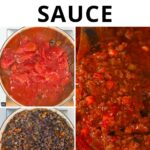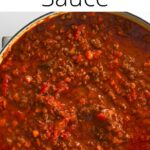This post may contain affiliate links. Please read our disclosure policy.
This pantry-friendly homemade spaghetti sauce recipe is simple to prepare, hearty, packed with flavor, and simmered low and slow over several hours! Freezer and canning friendly!
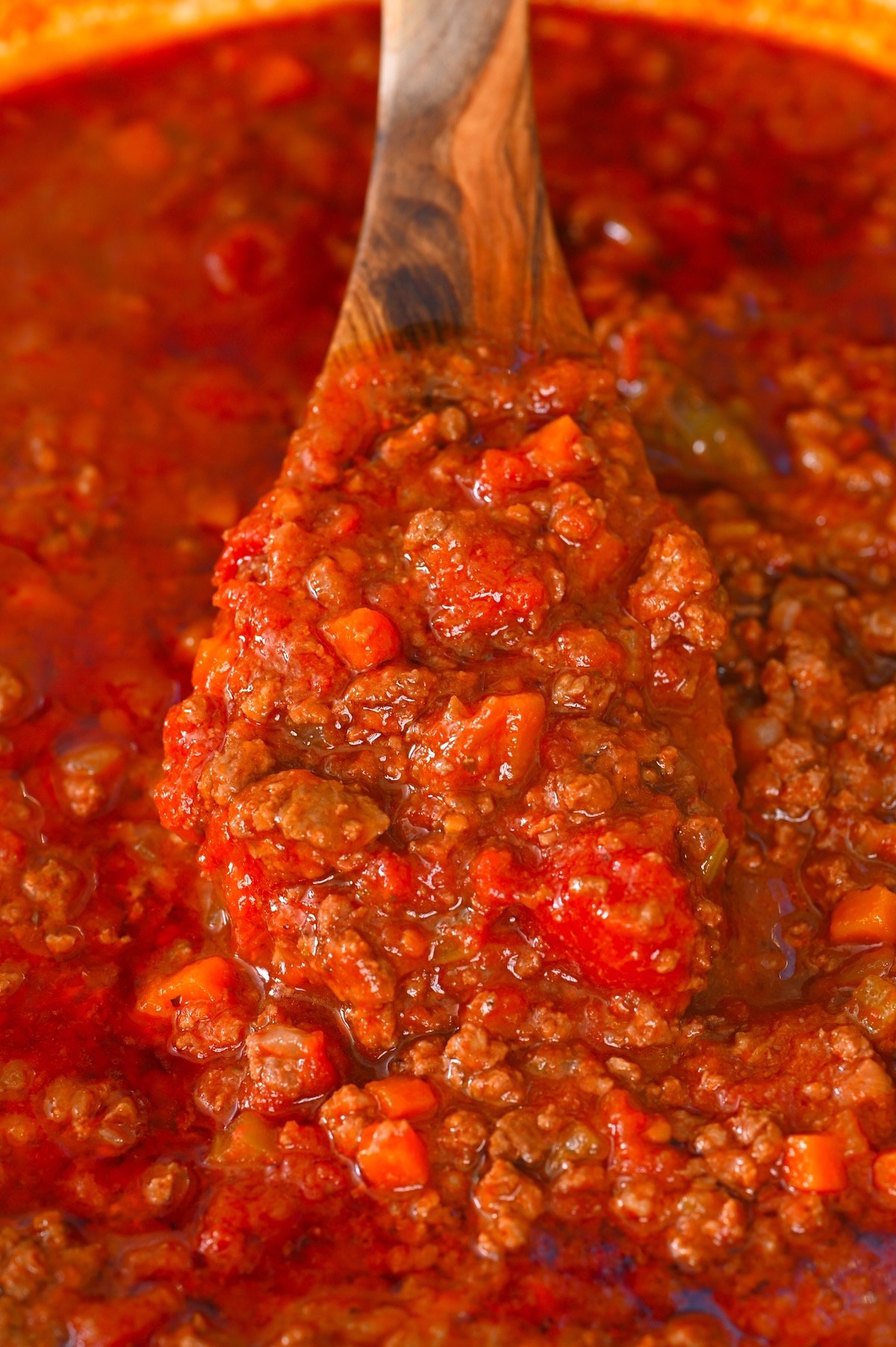
Simple pasta dishes like pasta Aglio e olio (garlic and olive oil), baked feta tomato pasta, and spaghetti Bolognese are a low-fuss family staple for busy evenings – I’m sure everyone will love this recipe. Especially if you, like me, prepare massive batches of this homemade spaghetti sauce to refrigerate or freeze for later. Did I mention it even tastes better on day two!?
With just 9 base ingredients, a simple method, and a long simmer (with just the occasional stir), this recipe for spaghetti sauce is ready to impress in all kinds of hearty meals like spaghetti Bolognese, lasagna, and more.
Even better, I’ve included stovetop, slow cooker, and Instant Pot methods below. And along with plenty of ingredient variations and add-ins, you can adapt this recipe to become the perfect, best homemade spaghetti sauce for YOU. I’m sure this homemade spaghetti meat sauce will taste way better than any grocery store-bought or jarred spaghetti sauces!
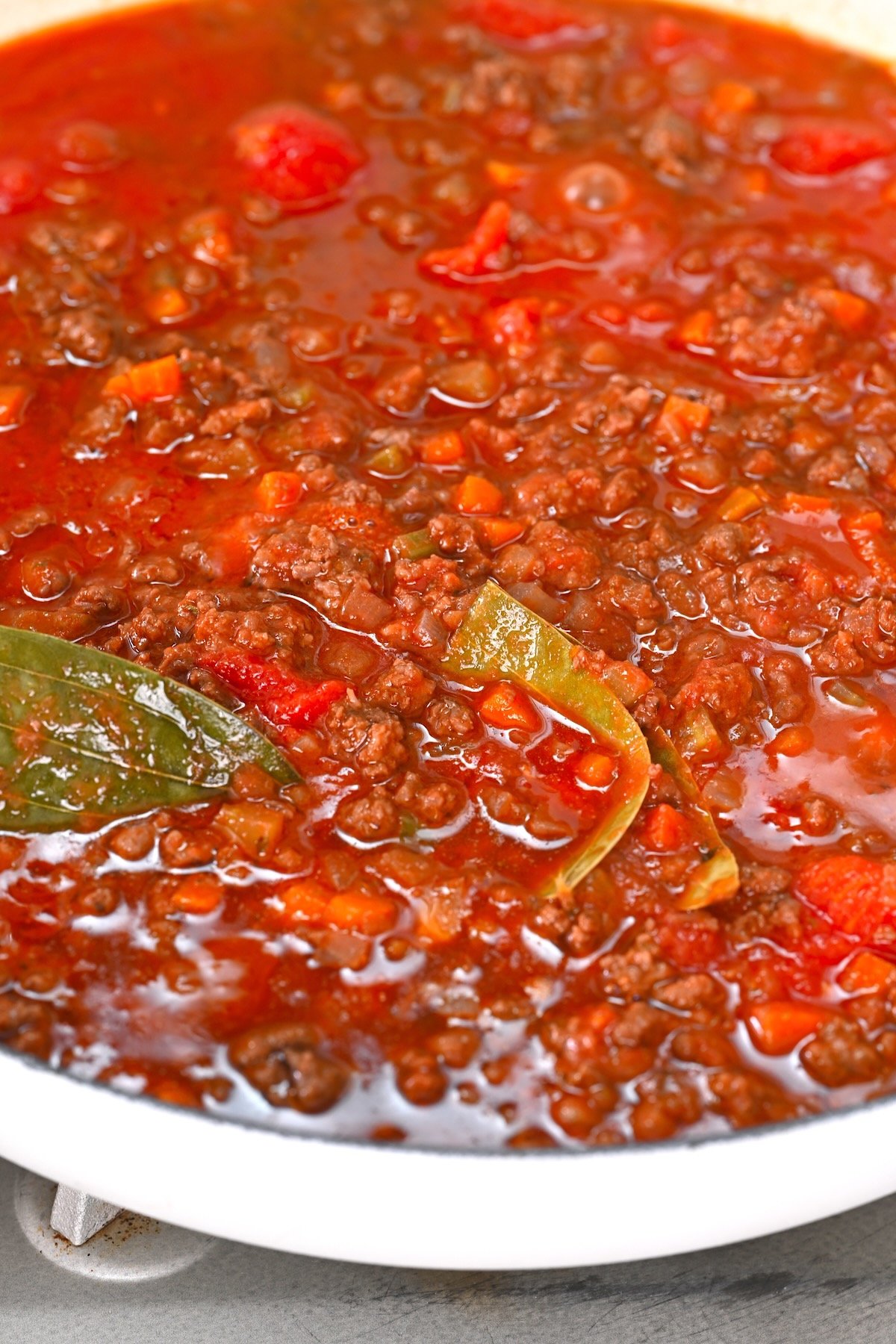
Want to save this recipe?
Table of Contents
Is Marinara Sauce the Same as Spaghetti Sauce
While both marinara and spaghetti sauce are tomato-based sauces (along with pizza sauce), the two are different.
Marinara sauce (pasta sauce) is a meat-free sauce made with tomatoes, garlic, and herbs, simmered to develop flavor.
In comparison, spaghetti sauce (also called Bolognese sauce) is a tomato and meat-based sauce that’s heartier and simmered for even longer. Once cooked, it’s ready to add to cooked spaghetti and dishes as is, with no additional protein/veg needed.
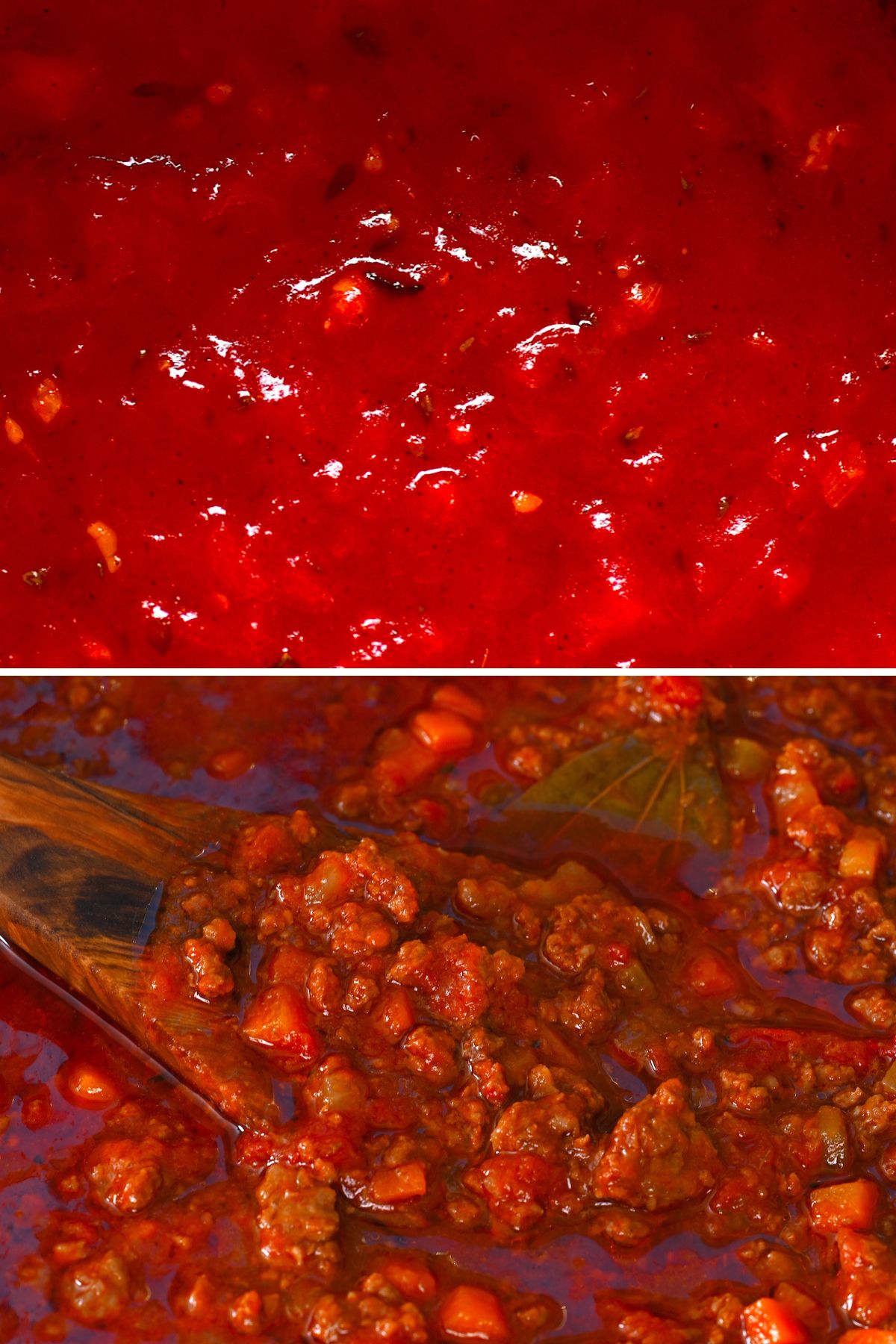
What to Put in Spaghetti Sauce?
This homemade spaghetti sauce recipe relies on a few ingredients most of which are likely already in your pantry.
- Ground beef: Use your desired level of fat for this spaghetti meat sauce. Alternatively, use ground Italian sausage or even a 50/50 combination of the two.
You could also use ground turkey or chicken, use soy protein for a vegan version, OR omit the protein entirely if you want to serve this sauce with meatballs.
- Sofrito: This spaghetti meat sauce recipe relies on the classic combination of onion, carrots, and celery to add depth of flavor.
- Tomatoes: This Italian spaghetti sauce recipe combines tomato paste and canned peeled tomatoes.
- Spices for spaghetti sauce: Dried oregano, bay leaf, salt, and black pepper. You can also add Italian seasoning, dried or fresh basil, and other spices – see my suggestions in the recipe card below.
- Olive oil: Or another neutral cooking oil.
- Water: Brings this simple spaghetti sauce with meat to the correct consistency. I rinse the tomato cans with a cup of water and use that. Or you can use vegetable stock.
- Red wine: (Optional) Add some dry red wine for extra richness and depth.
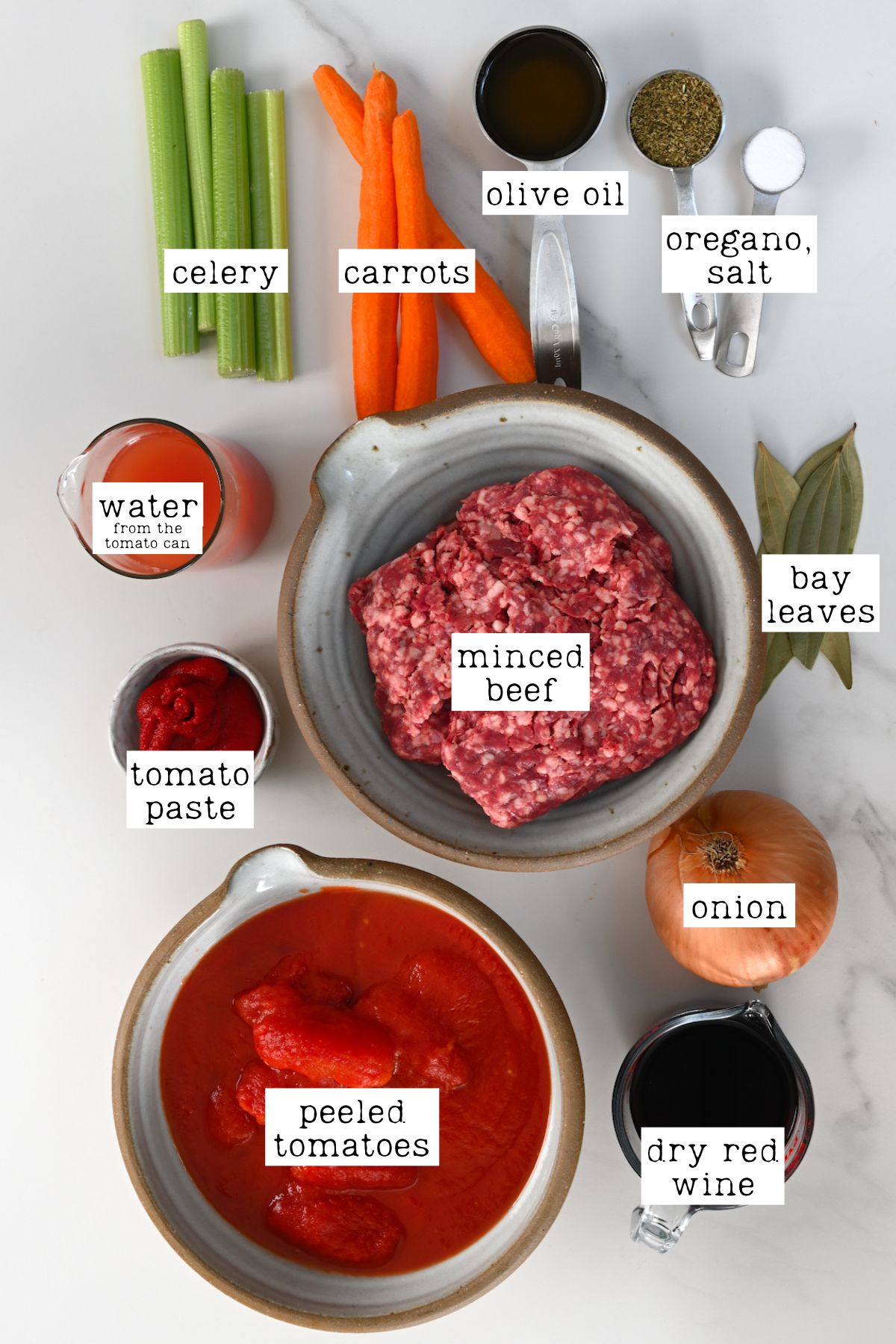
What Kind of Tomatoes Are Best for Spaghetti Sauce
This tomato-based sauce relies on the best tomatoes to make the best spaghetti sauce recipe. Therefore, I recommend using high-quality canned tomatoes like DOP San Marzano tomatoes or Pacchino tinned tomatoes, which are sweeter and less acidic with a robust tomato flavor.
I prefer to use whole tomatoes rather than crushed tomatoes for the best flavor and texture, but either works. During tomato season, you can even use a combination of canned and (blanches and peeled) vine-ripened tomatoes.
How to Make Spaghetti Sauce
While this easy homemade spaghetti sauce from scratch isn’t the quickest out there, the process is incredibly simple to follow.
First, rinse and finely chop the carrot, celery, and onion.
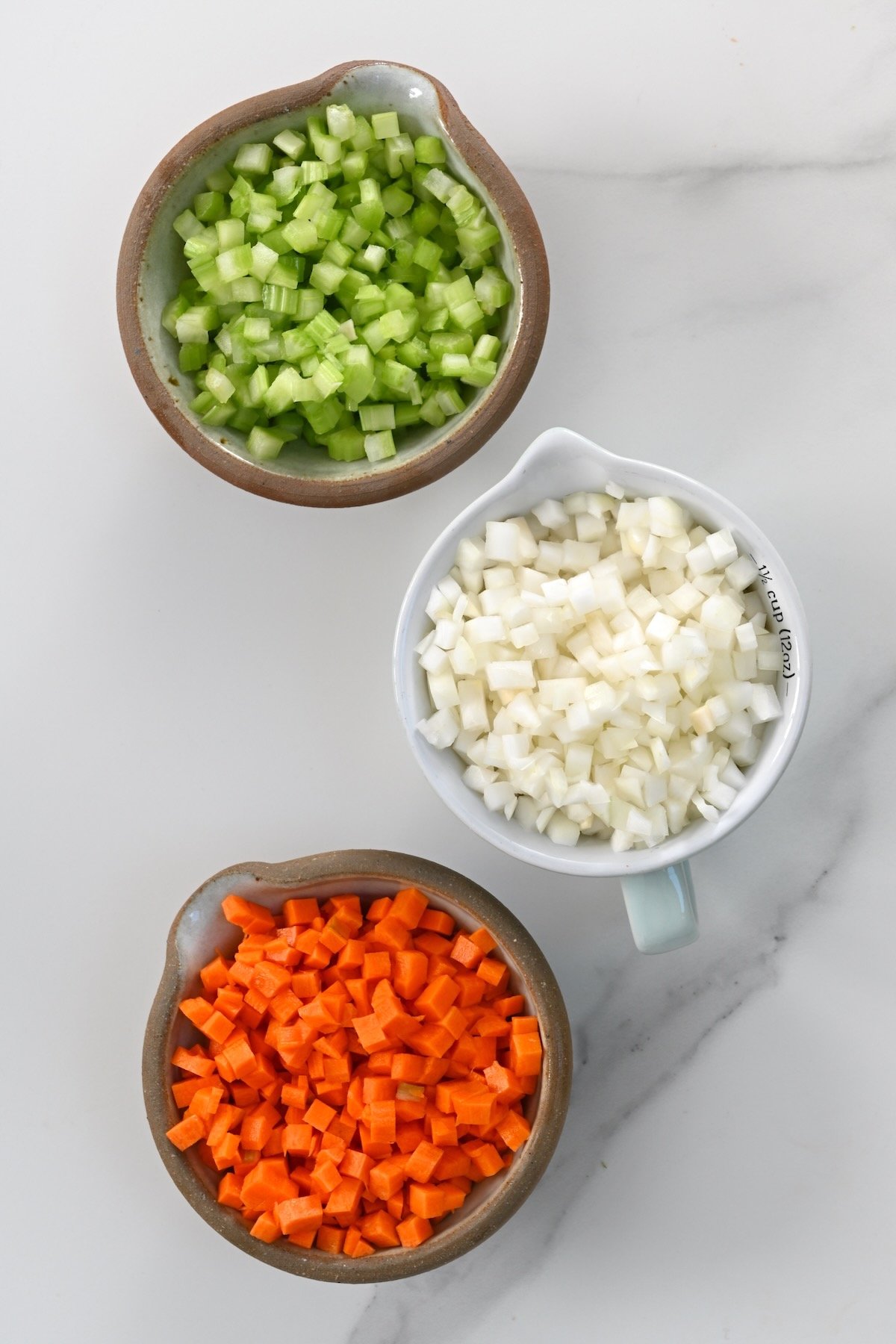
The Stove Top Method
Heat the oil in a large, thick-based pan over medium-high heat. Once hot, add the onion and sauté for a minute or two. Then add the carrot and celery and continue to cook, stirring often, for 5 minutes. Cook until the veggies are brown and become tender.
Then, add the meat and allow it to brown, breaking it into little pieces as you go.
I used fairly lean beef, so I didn’t feel the need to drain the excess grease afterward. However, do so if preferred.
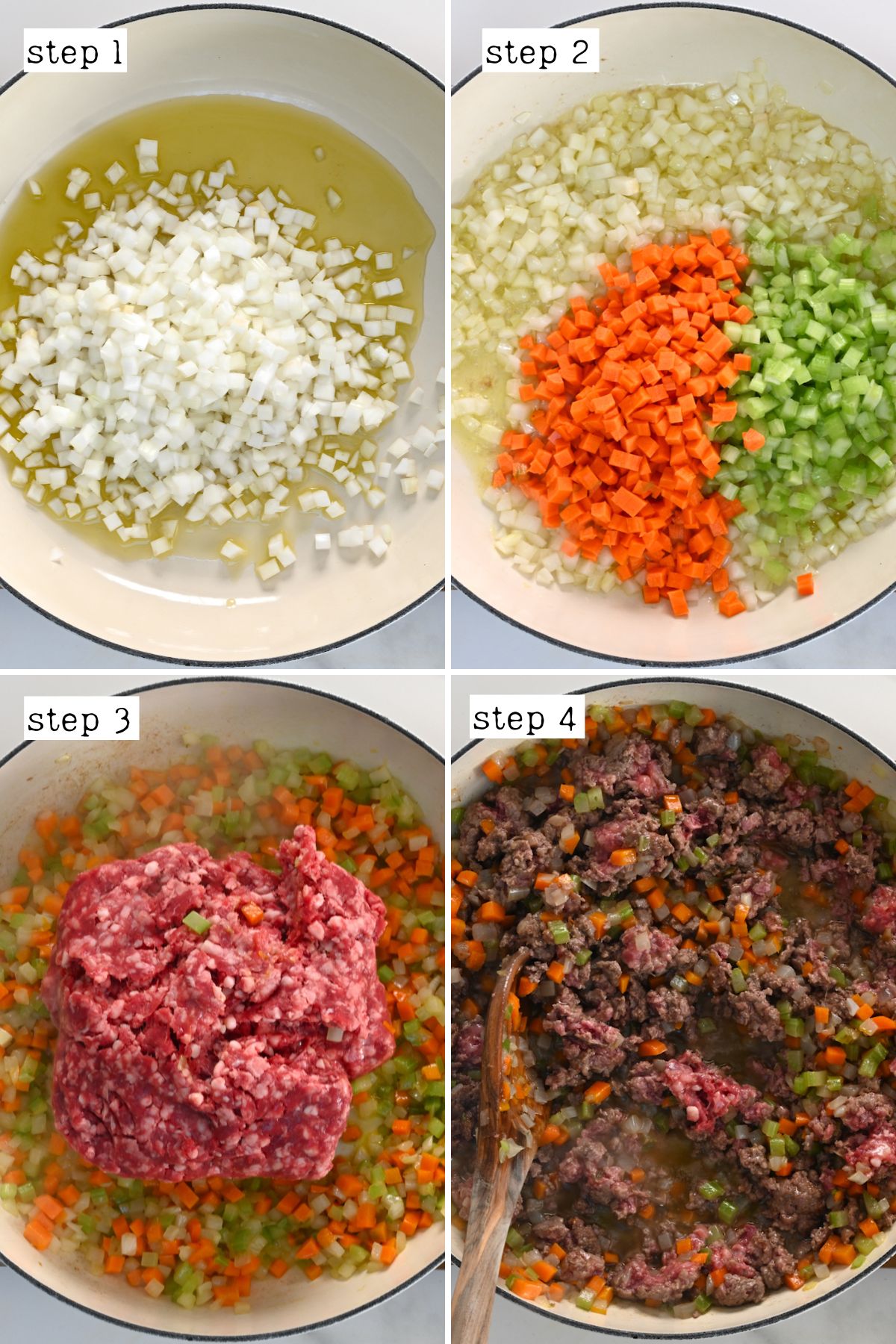
Then, when the meat is no longer pink, add the salt, oregano, bay leaves, and wine (if using) – allowing the wine to evaporate for a couple of minutes.
Add the tomato paste, stirring well, and cook for 2-3 minutes.
Then, add the canned tomatoes and the water (or vegetable stock). Lower the heat to low, stir well, and allow the homemade spaghetti sauce to simmer covered for 2 ½-3 hours, stirring occasionally.
Finally, give the sauce a taste and adjust the seasonings if necessary, then enjoy!
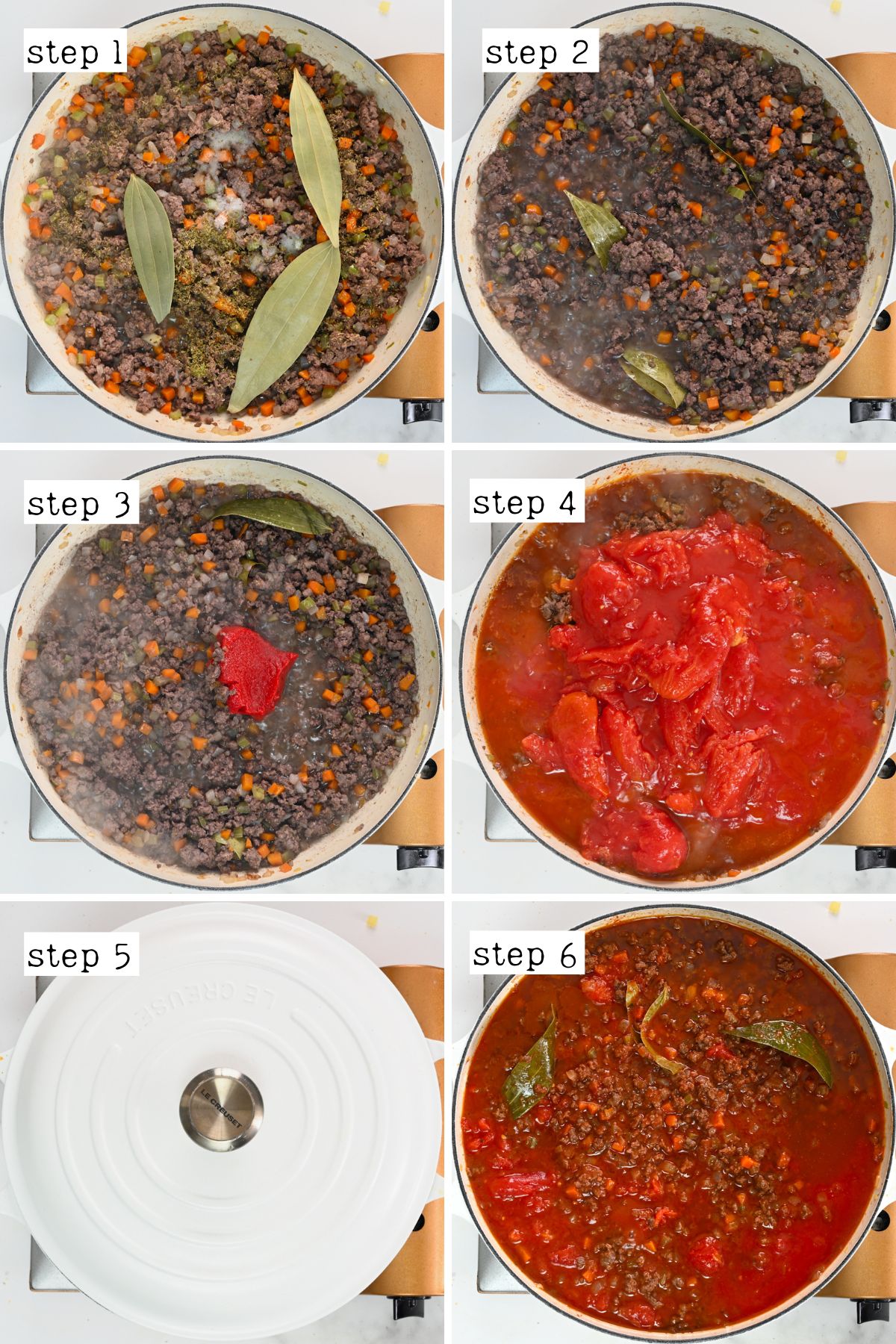
The Slow Cooker Method
Since this sauce benefits from low and slow simmering, a slow cooker is a perfect way to achieve these results with minimal hovering.
Follow the first few steps of the recipe above until you add the canned tomatoes and water/broth, then transfer everything to your slow cooker and cook on LOW for 8-10 hours or HIGH for 4-5 hours.
The Instant Pot Method
To save time, skip the slow stovetop simmer and transfer the spaghetti meat sauce to an Instant Pot.
Simply sauté the ingredients as written in the recipe. Then, when it comes time to simmer the sauce, cook it on manual HIGH pressure for 12 minutes, then natural release for 5 minutes.
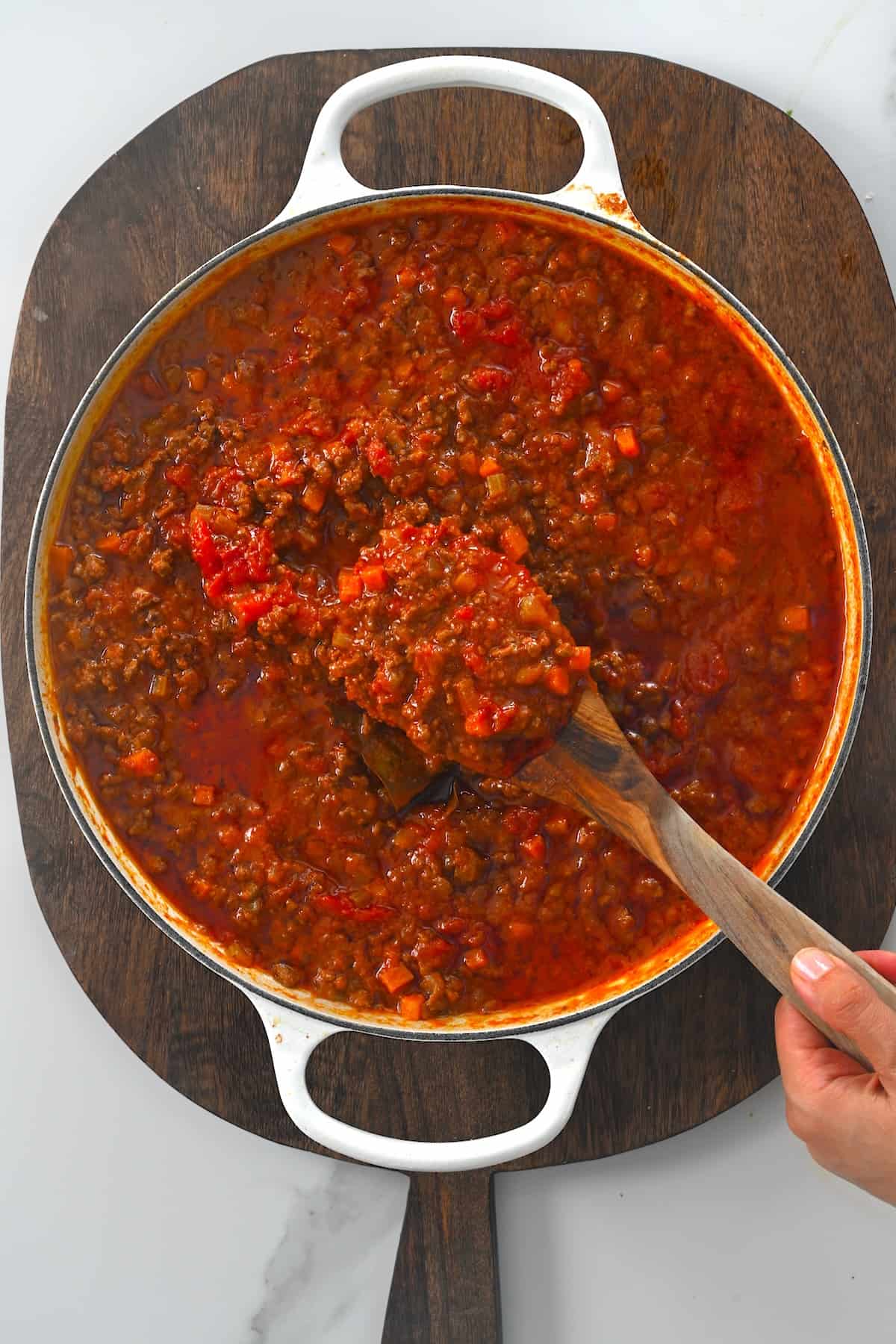
How Long Does Spaghetti Sauce Last in the Fridge
Allow it to cool, then store it in an airtight container in the refrigerator for 4-5 days.
You can reheat the meat sauce on the stovetop over medium-low heat or in a microwave. Add a splash of extra liquid (water or vegetable stock) to bring it back to a looser consistency if needed.
How to Freeze Spaghetti Sauce
I like to portion mine into reusable Ziplock freezer bags (spread flat to freeze, then store upright), but any freezer-safe airtight containers will work, too. Store for 4-6 months. Allow it to thaw in the fridge overnight before reheating it or even reheat it from frozen.
How to Can Spaghetti Sauce
To water bath canned this easy recipe, follow my canning guide to sterilize the jars and bring a large pan of water to a boil before canning spaghetti sauce. Use a trivet/rack in the pan to place the jars on so they aren’t touching the bottom of the pan.
Then, add 2 tablespoons of lemon juice (or ½ tsp citric acid) per quart of sauce. This is necessary to make the sauce acidic enough for canning. Finally, transfer the sauce to the jars (leaving ½-inch headspace), wipe the lips, and seal them.
Transfer the sealed jars of spaghetti sauce to the pan, submerged with at least an inch or two of water. Bring the water back to a boil, add the lid, and allow it to process for 40 minutes for altitudes of 1000ft or less. For up to 3k, add 5 minutes, 6k add 10 minutes, 8k add 15, and 10k add 20.
Transfer the cans to a kitchen-towel-lined surface to fully cool, check the seal, and then store them in a cool, dark location for up to 2 years.
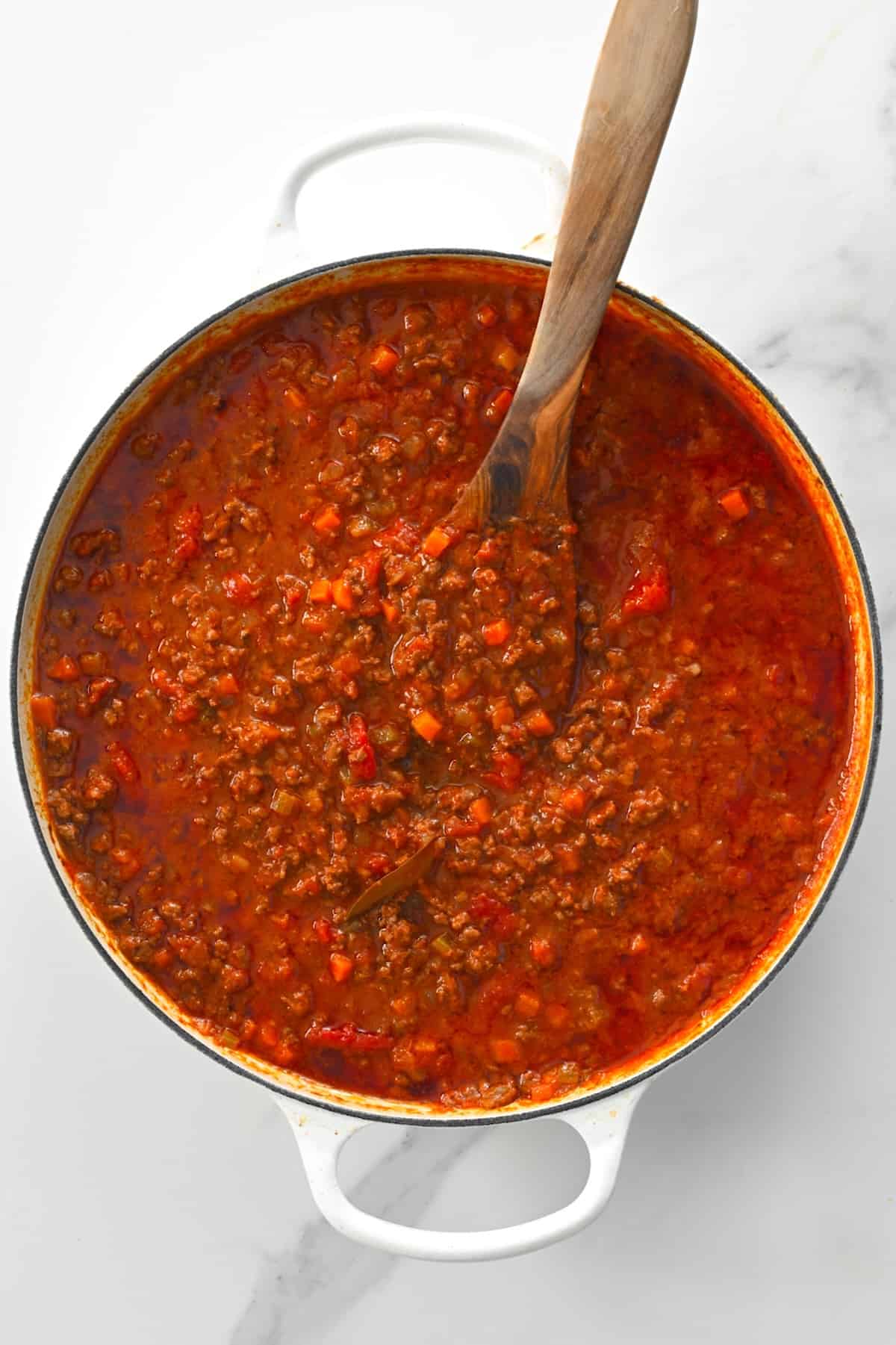
FAQs
There are plenty of ways to enjoy this spaghetti sauce, and not just with pasta. Here are a few of my favorite spaghetti sauce recipes.
– Make spaghetti Bolognese,
– Add to a lasagna or ziti casserole,
– Use as a base for shepherd’s pie,
– Scoop over a baked potato or fries,
– Top fully loaded nachos,
– Use within this potato gratin,
– Use within stuffed vegetables,
– Create a casserole,
– Turn it into a shakshuka.
If you find your tomatoes particularly acidic, adding a pinch of sugar helps balance the flavors. Alternatively, you could use baking soda, but you need practically just a few grains, so be careful with this. Otherwise, you’ll ruin the flavor.
If you save 1/4-1/2 a cup of pasta water to add to the sauce, this starchy water will help bind the sauce and the pasta. It’s also a natural thickener.
Add a cornstarch slurry of ½-1 tbsp cornstarch with 2 tbsp water (mixed until lump-free) to the homemade spaghetti sauce recipe at the end of the cooking process and stir constantly until thickened. It requires heat to activate, so increase the heat if necessary.
Why not?! It also works well over mini pizzas like stuffed mushroom cap pizzas, eggplant pizzas, etc.
Yes, though I recommend blanching (for 60 seconds) and peeling the tomatoes first, so there aren’t lots of peelings in the sauce.
More Pasta Sauce Recipes
If you try this delicious homemade spaghetti sauce recipe, I’d love to hear your thoughts/questions below. Also, I’d appreciate a recipe card rating below, and feel free to tag me in your recipe recreations on Instagram @Alphafoodie!
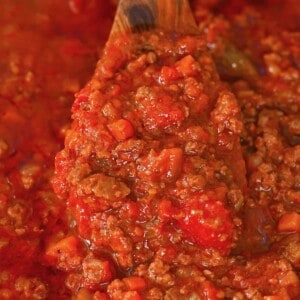
The Best Spaghetti Sauce (Better Than Store Bought)
Ingredients
- 2.2 lb lean minced beef or 50/50 beef and Italian sausage; ground turkey and chicken would also work
- 11.3 oz onion 1 large
- 6 oz carrots 3 medium
- 4.5 oz celery 2 sticks
- 3 oz tomato paste 1/4 cup
- 2.64 lb peeled tomatoes 3 14oz cans. I recommend DOP San Marzano
- 1 Tbsp dried oregano
- 1/2 Tbsp salt
- 1/3 cup olive oil
- 3 bay leaves
- 1 cup red wine dry; optional
- 1 cup water OR vegetable stock; I love rinsing the tomato cans with it
Instructions
- Rinse and finely chop the carrot, celery, and onion.
- Heat the oil in a large, thick-based pan over medium-high heat. Once hot, add the onion and sauté for a minute or two. Then add the carrot and celery and continue to cook, stirring often, for 5 minutes. Until the veggies are brown and become tender.
- Add the meat and allow it to brown, breaking it into little pieces as you go.I used fairly lean beef, so I didn't feel the need to drain the excess grease afterward. However, do so if preferred.
- Add the salt, oregano, bay leaves, and wine (if using) – allowing the wine to evaporate for a couple of minutes.
- Add the tomato paste, stirring well, and cook for 2-3 minutes.
- Add the canned tomatoes and the water (or vegetable stock). Lower the heat to low, stir well, and allow the homemade spaghetti sauce to simmer covered for 2 ½-3 hours, stirring occasionally.
- Give the spaghetti meat sauce a taste and adjust the seasonings if necessary, then enjoy!
The Slow Cooker Method
- Follow the first few steps of the recipe above until you add the canned tomatoes and water/broth, then transfer everything to your slow cooker and cook on LOW for 8-10 hours or HIGH for 4-5 hours.
The Instant Pot Method
- Simply sauté the ingredients as written in the recipe. Then, when it comes time to simmer the sauce, cook it on manual HIGH pressure for 12 minutes, then natural release for 5 minutes.
Storage Instructions
- Store: Allow it to cool, then store in an airtight container in the refrigerator for 4-5 days.To Freeze: I like to portion mine into reusable Ziplock freezer bags (spread flat to freeze, then store upright), but any freezer-safe airtight containers will work, too. Store for 4-6 months and then allow it to thaw in the fridge overnight before reheating it or even reheating it from frozen.Reheat: You can reheat the spaghetti meat sauce on the stovetop over medium-low heat or in a microwave. Add a splash of extra liquid (water or vegetable stock) to bring it back to a looser consistency if needed.
Video
Notes
- Use high-quality ingredients: This Italian spaghetti sauce recipe is only as good as the tomatoes used to make it!
- The “cheat” method: use marinara sauce as your tomato base.
- Allow the soffrito to brown: Allowing the sauteed veggies to lightly brown will add a TON of depth to the homemade spaghetti sauce recipe.
- How long to simmer spaghetti sauce? The key is to simmer the spaghetti sauce recipe for as long as possible to bring out the most flavor without overcooking the meat. I recommend a minimum of one hour up to 4 hours for the optimal length.
- Don’t under-simmer the sauce: With a short simmering time, the ingredients won’t have melded, the flavor will be overly acidic, and you can pick out individual flavors rather than them being melded. It just isn’t good!
- If the sauce becomes too thick: Add a little extra water or vegetable stock.
- Soy sauce: Use in place of regular salt for added umami. Use tamari or coconut aminos if you’re gluten-free.
- Worcestershire sauce: Add a subtle tang and delicious depth to the sauce.
- Spice: Add spice by using Red pepper flakes, chili powder, and cayenne powder.
- Paprika: Use plain or smoked paprika to add depth.
- Herbs: A small amount of dried parsley (or fresh parsley) or a teaspoon or two of dried basil would work alongside oregano. Fresh basil also works. Instead of oregano, add Italian seasoning.
- Fennel seeds: A generous pinch (or slightly more) will add extra flavor.
- Sugar: To add if the sauce is very acidic.
- Bell pepper: Any color, finely diced.
- Mushrooms: Some sliced mushrooms help to add flavor and even more “meatiness.”
- Butter: Add a couple of tablespoons (or more) for added richness and buttery-ness.
- Anchovies: (or a dollop of anchovy paste) sauteed with the initial veg, removed and then added again when simmering.
- Black olives: for little bites of briny saltiness.
- Spinach: Add at the end, and the residual heat will wilt it.
- Parmesan cheese rind: Add to the sauce while it simmers, then remove for enhanced flavor.
Nutrition
Nutrition information is automatically calculated, so should only be used as an approximation.



